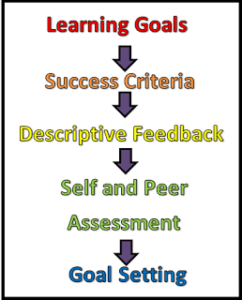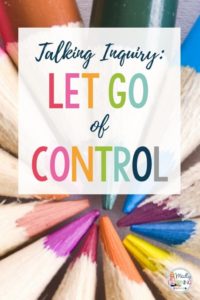 Today I wanted to focus on learning goals and success criteria and how they are the center of your inquiry teaching practice. I talked about a lot of things today on my broadcast, and wanted to share my notes with you as well as some pictures of how these look in my classroom. Check out the video here if you missed it.
Today I wanted to focus on learning goals and success criteria and how they are the center of your inquiry teaching practice. I talked about a lot of things today on my broadcast, and wanted to share my notes with you as well as some pictures of how these look in my classroom. Check out the video here if you missed it.
What is Inquiry:
“Inquiry” is student-centered teaching that turns student interest and curiosity into real learning through questioning, investigating, observing and collaborating.
Learning Goals and Success Criteria
A learning goal is your big idea often based on your curriculum expectations or standards. They are sentences written in student-friendly language and often start with key-word sentence starters such as
- “We are learning about…”
- “We want to know more about…”
- ” I can….”
Some examples that we have used in my classroom about learning goals are
- First Nations and Early European Explorers – “What was life like for the First Nations before contact”
- Human Body – We are learning about the digestive system and how it helps to keep your body working and healthy
- Structures – “We are learning about internal and external forces that impact the strength of a structure”
 |
| Summarizing and narrowing down student questions |
 |
| Our Learning Goals in the center of our bulletin board with the picture of the wonder wall surrounding it. For this unit we used questions as our learning goals instead of typical learning goal “We are learning about…” statements. |
 |
| This is the list we co-created about the success criteria for the first learning goal of our unit. Again not perfect but it reflected our conversations and understandings of what we needed to explore. |
 |
| Although they are too small to read here, this is a picture of our whole human body unit with learning goals and success criteria for each system and learning activities. We added our learning as we went along to our Wonderwall board. We included evidence of activities that showed our learning and accomplishment of learning goals and success criteria. |
Why are learning goals important?
Students need to know where they are going and what they are doing. Learning Goals and Success criteria are the road map you give your students at the beginning to know what they will be assessed on as they learn. This is very explicit. These are the test questions that you give them weeks in advance and a guide to have them show what they know by the end. If they can show you that they have learned what you set out to have them learn then they have been successful.
How to use them in an Inquiry Classroom.
- Co – create them with students and have them contribute their interests and knowledge to the learning decisions. This will increase engagement because you are helping them learn what they tell you they are interested in.
- This part of your inquiry journey happens after your knowledge building circle and Wonder wall session. This is the step that guides the rest of your learning.
- take their questions from their wonder wall and group them into categories and try to make sense of the themes of their questions. This is not totally on them your selection of the questions help you to manipulate the direction of the learning while students may identify the themes or focus.
- Introduce the subtopics to your students and have them discuss the themes of where they are going in their learning. Have them help you to explore where they will be going and what they will be learning about. Ask them what they think the big idea is. We want to know more about…, or We will be learning about…
- From there organize your sentences into an order for learning. What organ system will you learn about first, second, and third. What makes the most sense to learn first. Often this should start off from simple to complex allowing students to build the necessary background knowledge. Knowledge that will be needed and necessary prior to them using higher-order thinking skills, critical thinking, and applying what they are learning to solve real world problems.
- Once they have developed the learning goal statements it is time to break down the first learning goal and determine how they are going to accomplish this task. Depending on your students comfort level and knowledge of the topic they may need more or less support from you to do this. Make a list of things they need to know. This may change as you go along and they gather more information. This can often be a messy part of the learning and sometimes the most difficult part. But pay attention to what your students are saying! This will give you a lot of insight on where students need and want to go with their learning and what gaps you will need to help them fill. Again you may need to provide more support for them at this stage if all you hear in your classroom is crickets.
- Remember that you are going to use this to help you students build their knowledge that stems from their own interests. Stop checking curriculum boxes and start helping your students meet their goals. You are there to guide them and facilitate their learning. Stop doing all of the work. It is time, that your students take ownership of their own learning and share the load. This will, in fact, reduce your planning time or at least change it as you are not preparing lessons but are finding resources to help students guide their own learning.
How to get them to use it?
- You need to use it.
- Make it the center of your conversations with students
- Reference it
- Point out that this is what they will be assessed on
- Follow the cycle of assessment to help keep them focused on this learning through regular conferences, check-ins, and observations.

-
Assessment of inquiry seems difficult, but in reality, if you have strong and explicit learning goals and success criteria, that forms the center of your learning. Then it is very easy for students to show you what they know. They can use them as a checklist for their learning. Simply just check off when they have accomplished a learning goal when they show you what they know about that topic and meet the success criteria. It becomes easier as you do this more often to evaluate whether or not they have shown a thorough understanding, a good understanding, or a simple understanding of the concepts that they have been learning.
Ready for the next step in inquiry? Up next learn how to let go of control so you can let students lead through student-centered inquiry.








